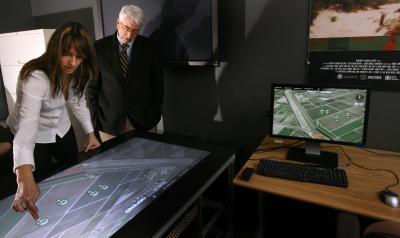Dante™, also part of the Borders HLM platform, is a force-on-force battle simulation tool built on the well-known Umbra simulation framework developed and introduced in 2001 by Sandia researchers.
The work also builds from another Sandia borders project from the mid-2000s (focused on the impact of new detection technology at ports of entry) and capitalizes on a range of existing Sandia capabilities, including the Weapons of Mass Destruction Decision Analysis Center (WMD-DAC), the National Infrastructure Simulation and Analysis Center (NISAC, a joint Sandia and Los Alamos National Laboratory program) and even the lab's expertise in robotics.
According to Reinhardt and Djordjevich, there were a number of technical challenges in integrating a mature modeling technology like Dante with a newer gaming technology like Ground Truth.
"We needed to create real-time control for the user, and our current capabilities weren't built to do that," Reinhardt said. "There's also the fact that we're modeling 64 square miles of border, and we need to do so at a pretty high fidelity," added Djordjevich, who pointed out that Ground Truth's terrain was originally developed at a fixed, small scale. To help overcome some of the barriers, Sandia has looked to some important collaborators.
The University of Utah provided a technology, Visualization Streams for Ultimate Scalability (ViSUS), which allows researchers to progressively stream in terrain and imagery data and minimize data processing requirements, an important consideration given that HLM requires many gigabytes of data. For its part, Happynin Games, an iPhone/mobile game development company, developed the 3-dimentional artwork and the characters found in the simulations. Sandia, acting as the systems integrator, then put all the pieces together, presented the Borders HLM product to CBP and demonstrated how it would allow them to go through all the steps of the "engagement analysis cycle."
"We learned that the border patrol agents and CBP decision-makers need a tool that offers a common view of the problems they face," said Reinhardt. "With our high level model, they can play through various scenarios and see how people, technology and other elements all interact. Then, later, they can go back and do a baseline analysis and dig into the details of why certain architectures and solutions aren't working as well as they should." CBP personnel can then play the game again with a recommended solution, and the end users can critique and tweak it to their liking.
With additional funding and the right kind of collaborations, Djordjevich said, more robust features could be added to make Borders HLM even more valuable to CBP and other potential customers. The current version, for instance, only deals with individual border crossers, so it doesn't capture crowd behaviors. Other sensor types, such as radiation detectors or even airborne equipment, could also be added.
Reinhardt says the future of the Borders HLM tool will likely depend on the direction in which CPB chooses to go with its border operations. "Our high-level models tool will likely change the way CBP conducts its business, and it will probably have a real long-term impact on how large expenditures are justified or reputed on and around the nation's borders."
Sandia National Laboratories is a multiprogram laboratory operated by Sandia Corporation, a wholly owned subsidiary of Lockheed Martin Corporation, for the U.S. Department of Energy's National Nuclear Security Administration. With main facilities in Albuquerque, N.M., and Livermore, Calif., Sandia has major R&D responsibilities in national security, energy and environmental technologies, and economic competitiveness.

Developed via funding from the Department of Homeland Security's Customs and Border Protection (CBP), the Borders High Level Model is a high-fidelity simulation and analysis program that aids policy and decision makers tasked with making key funding choices. Borders HLM uses serious gaming, force-on-force simulation, and a range of other Sandia capabilities.
(Photo Credit: Sandia National Laboratories / California)

Sandia researcher Donna Djordjevich (left) demonstrates the Borders High-Level Model (HLM) to a visitor.
(Photo Credit: Dino Vournas (Sandia National Labs))
Source: DOE/Sandia National Laboratories